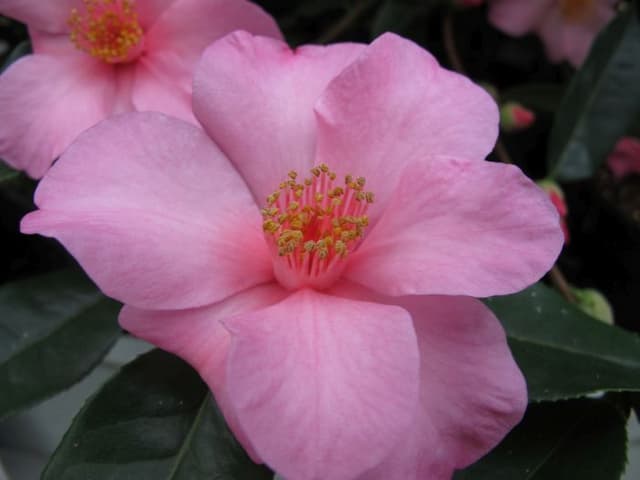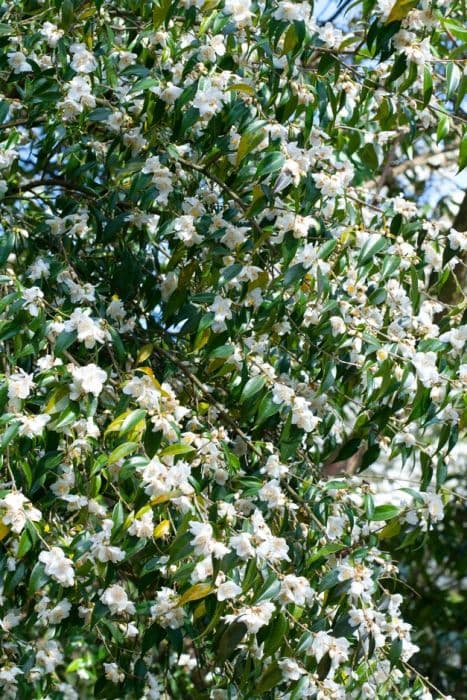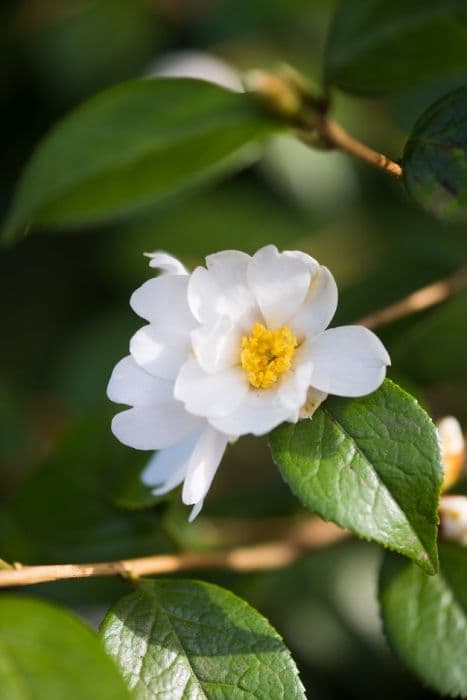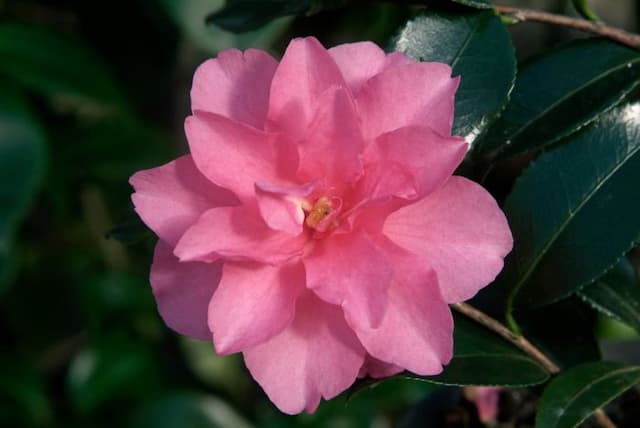Camellia Camellia × williamsii 'Jenefer Carlyon'

ABOUT
Camellia × williamsii 'Jenefer Carlyon' is a visually striking cultivar known for its ornamental value and beautiful flowers. This plant is characterized by its evergreen foliage, providing a year-round display of glossy, dark green leaves. These leaves are typically oval-shaped with a slightly serrated edge, forming an elegant backdrop that highlights the blooms. The flowers of 'Jenefer Carlyon' are the plant's most remarkable feature, attracting attention during its blooming season, which usually occurs in the late winter to spring. The blossoms are large and showy, often having a ruffled or peony-like form. Their color is an exquisite shade of light pink, sometimes with deeper pink streaks or shading, and they may possess a slightly iridescent quality. At the center of each flower, there's a cluster of prominent golden stamens, which adds a contrasting feature to the delicate pink petals. The overall impression is one of classic beauty and refinement, making 'Jenefer Carlyon' a popular choice for gardens and landscaping where a touch of elegance is desired. The plant typically has a bushy and dense habit, with a well-branched structure that allows it to support the luxurious blooms. Due to the exclusion of references to its dimensions, the emphasis remains on the exquisite aesthetic attributes that 'Jenefer Carlyon' offers to any planting scheme.
About this plant
 Names
NamesFamily
Theaceae
Synonyms
Williamsii Camellia, Hybrid Camellia
Common names
Camellia × williamsii 'Jenefer Carlyon'.
 Toxicity
ToxicityTo humans
The plant commonly known as the Camellia has no significant toxicity to humans. Ingesting parts of the Camellia plant typically does not lead to poisoning or severe adverse effects. It is generally considered safe around humans regarding its potential for toxicity.
To pets
The Camellia plant is also considered non-toxic to pets such as cats and dogs. If a pet ingests part of a Camellia plant, it is unlikely to experience poisoning or serious health issues as a result. However, ingestion of any plant material can potentially cause mild gastrointestinal upset in some pets.
 Characteristics
CharacteristicsLife cycle
Perennials
Foliage type
Evergreen
Color of leaves
Green
Flower color
Pink
Height
6-10 feet (1.8-3 meters)
Spread
5-8 feet (1.5-2.4 meters)
Plant type
Shrub
Hardiness zones
7
Native area
East Asia
Benefits
 General Benefits
General Benefits- Ornamental Value: Camellia × williamsii 'Jenefer Carlyon', commonly known as camellia, offers stunning, large pink flowers that enhance the visual appeal of gardens and landscapes.
- Long Blooming Season: Camellias typically have a prolonged blooming period, which can extend from late fall through early spring, providing color during the cooler months when few other plants are in flower.
- Drought Tolerance: Once established, camellias can tolerate periods of drought, making them suitable for gardens in regions with occasional water scarcity.
- Shade Tolerance: Camellias are able to flourish in partially shaded areas, giving gardeners the flexibility to plant them in a variety of light conditions.
- Evergreen Foliage: Camellias provide year-round greenery with their glossy, evergreen leaves, creating constant visual interest and structure in the garden.
- Wildlife Attraction: The flowers of camellias can attract pollinators like bees during their bloom time, supporting local ecosystems.
- Low Maintenance: Camellias require relatively low maintenance, needing only occasional pruning to remove dead or crossing branches and to maintain their shape.
- Versatility: These plants can be used in various landscape designs, including as specimen plants, in shrub borders, or as foundation plantings.
 Medical Properties
Medical PropertiesThis plant is not used for medical purposes.
 Air-purifying Qualities
Air-purifying QualitiesThis plant is not specifically known for air purifying qualities.
 Other Uses
Other Uses- As a natural dye: The petals of Camellia × williamsii 'Jenefer Carlyon' can be used to create natural dyes for fabrics, offering a range of colors from pale pinks to deeper hues.
- Educational uses: This plant can be used for botanical studies and plant identification courses due to its distinct characteristics and hybrid nature.
- Photography subject: With its beautiful flowers and attractive foliage, the Camellia × williamsii 'Jenefer Carlyon' can be used by photographers to practice macro photography and capture the beauty of nature.
- Culinary presentation: Although not edible, the blossoms can be used as a garnish for plating in high-end culinary presentations to add a splash of color.
- Eco-friendly confetti: Dried petals of Camellia × williamsii 'Jenefer Carlyon' offer an environmentally friendly alternative to traditional paper confetti at events and celebrations.
- Art and crafts: The distinct petals can be used in art projects or for making natural crafts, such as flower pressing or in potpourri mixtures.
- Bathing rituals: The flowers can be floated in baths as a luxury, decorative element for a spa-like experience at home.
- Garden photography workshops: The plant can be a focus in gardening or nature photography workshops as a model for teaching techniques in outdoor photography.
- Botanical ink: The pigments from the petals can be extracted to make botanical inks for traditional or artistic writing practices.
- Wedding decor: The flowers can be incorporated into wedding ceremonies as part of the venue decorations, adding their elegant blooms to the romantic setting.
Interesting Facts
 Feng Shui
Feng ShuiThe Camellia is not used in Feng Shui practice.
 Zodiac Sign Compitability
Zodiac Sign CompitabilityThe Camellia is not used in astrology practice.
 Plant Symbolism
Plant Symbolism- Adoration - Camellias generally symbolize adoration, making them a perfect gift to express admiration or deep affection towards someone.
- Perfection and Excellence - The exquisite beauty of the Camellia 'Jenefer Carlyon' is often associated with the pursuit of perfection and excellence.
- Longevity - As Camellias are evergreen and can live for many years, they can symbolize longevity and the enduring nature of love.
- Deep Desire - The intense and vibrant colors of Camellia blooms can represent deep desire or a yearning heart.
- Devotion - Camellias can also signify the steadfast devotion one person may feel for another, embodying loyalty and commitment.
 Water
WaterWilliamsii camellias should be watered deeply and thoroughly to encourage deep root growth; allow the top inch of soil to dry out between waterings. Generally, watering once a week is sufficient, but during periods of drought or extreme heat, you may need to water twice a week. To avoid water waste and ensure the plant gets enough, apply 1 to 1.5 gallons of water for small or medium-sized shrubs and up to 2.5 gallons for larger ones each time you water.
 Light
LightWilliamsii camellias thrive in partial shade with dappled sunlight. They should be protected from the intense afternoon sun which can scorch the leaves, so situate them in a spot that receives morning light and afternoon shade. An ideal location is under the canopy of tall trees that filter the sunlight.
 Temperature
TemperatureWilliamsii camellias prefer moderate temperatures and can survive in a range between 20 and 85 degrees Fahrenheit, though they perform best when the temperature is between 60 and 70 degrees Fahrenheit. They can endure brief periods of colder weather, but prolonged exposure to temperatures below 20 degrees can be damaging.
 Pruning
PruningPruning Williamsii camellias is mainly done to shape the plant and remove dead or weak wood. Pruning should occur after flowering ends in the spring, but before the new vegetative growth cycle starts. Once a year is typically enough for pruning these camellias.
 Cleaning
CleaningAs needed
 Soil
SoilThe Camellia Williamsii 'Jenifer Carlyon' thrives best in acidic soil with a pH range of 5.5 to 6.5. The ideal soil mixture for this camellia includes a combination of two parts ericaceous compost to one part perlite or pine bark for increased drainage and aeration.
 Repotting
RepottingCamellia Williamsii 'Jenifer Carlyon' should be repotted every 2-3 years during its growing phase, typically in the spring. Choose a slightly larger pot to allow space for growth and use fresh acidic soil mix when repotting.
 Humidity & Misting
Humidity & MistingThe Camellia Williamsii 'Jenifer Carlyon' prefers high humidity, ideally between 50% and 60%. This can be maintained through the use of humidity trays or misting, ensuring the leaves do not remain wet overnight to prevent disease.
 Suitable locations
Suitable locationsIndoor
Place near bright, indirect light and maintain high humidity.
Outdoor
Plant in partial shade, shelter from strong winds, mulch soil surface.
Hardiness zone
7-9 USDA
 Life cycle
Life cycleThe Camellia × williamsii 'Jenefer Carlyon', commonly known as a hybrid camellia, begins its life cycle with seed germination, which is uncommon in cultivated varieties as they are usually propagated by cuttings. After rooting, the young plant enters a vegetative growth phase, developing glossy, evergreen leaves and a sturdy stem structure. As the plant matures, typically within a few years, it begins to flower, producing ivory-white blossoms with a delicate blush and yellow stamens, usually from late winter to early spring. Following pollination, which is often achieved through the activity of insects, the plant may produce dry seed capsules containing seeds that can be dispersed, although cultivated plants are often propagated vegetatively. The plant then enters a period of rest or reduced activity during the colder months, conserving energy for the next growing season. Throughout its life, which can span decades, the camellia will undergo cycles of growth, flowering, and dormancy, maintaining a bushy, evergreen presence in the landscape.
 Propogation
PropogationPropogation time
Spring-Early Summer
The most popular method of propagation for Camellia × williamsii 'Jenefer Carlyon', commonly known as Williamsii camellia, is through semi-hardwood cuttings. This typically occurs during the late summer, after the new growth has begun to firm up. To do this, take a cutting of about 4 to 6 inches (10 to 15 cm) in length from a healthy stem, ensuring it has several leaves. The lower leaves should be removed and the cut end dipped in rooting hormone. The cutting is then placed in a pot filled with a mix of peat and perlite or sand, ensuring the cut end is well lodged in the growing medium. The pot is positioned in a warm place with bright, indirect light and covered with a plastic bag or placed in a propagator to maintain humidity. Roots typically develop within a few weeks to a couple of months, after which the new camellia plant can be transplanted.









